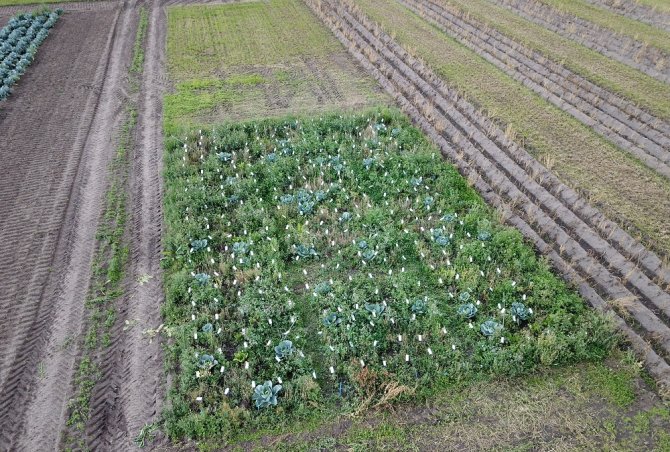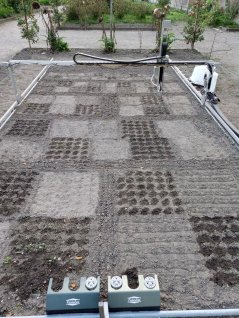
Project
Pixel cropping
Evidence is building that the use of more species in arable fields has strong positive effects on crop yields, resource-use efficiency, biodiversity, and pest, pathogen and weed suppression (1-5). Research has also shown that smaller field sizes and higher resolutions of diversity within the field (i.e. smaller-scale intercropping) can deliver more ecosystem services than bigger areas of sole crops (6-8). Inspired by this evidence, we initiated the WUR pixel cropping experiments to test 'extreme' levels of in-field crop diversity. We want to know if simultaneously introducing diversity in three dimensions (space, time, and genes) and at high resolutions can maintain good yields and also deliver other agro-ecosystem services.

What is pixel cropping?
Pixel cropping (also known as pixel farming, pixelfarming, or pixelteelt in Dutch) is a cropping system design and management method that mobilizes high-resolution diversity in arable fields. It is grounded in the hypothesis that high-resolution spatial, temporal, and genetic diversity will enhance ecological processes that support crop production and agro-ecosystem service delivery. In pixel plots we grow multiple food and service crops in complex arrangements in which individual communities of plants are allocated to small 'pixels'. Ideally, pixel plots should be designed so that the right plant community is allocated to the right location, at the right time, and at the right resolution. Determining what is right for each plant community should be based on the intrinsic behavior and needs of each crop and the (dis)services it provides to its neighbors. Pixel size and shape should be determined by the optimal ecological niche of each crop and the context in which it is grown, and matching crop communities to the right place in the field should be determined based on soil characteristics and othervenvironmental factors.
WUR pixel cropping trials

The Farming Systems Ecology group currently runs pixel cropping trials at three locations: on-station at WUR's Droevendaal Organic Experimental and Training Farm in Wageningen, and on-farm at Landgoed Zuylestein in Amerongen and at Landgoed Velhorst in Lochem. At Droevendaal, six different crops are grown in 50cm x 50cm pixels and allocated randomly within a fixed grid in two 9m x 12m plots. The random arrangement allows us to investigate the effect of a variety of neighbouring crops on the measured ecosystem services. At Zuylestein, we us a FarmBot XL to plant and tend pixels of multiple sizes and shapes in a 3m x 6m plot. Here we test "good" and "bad" crop combinations, determined through literature review. At Landgoed Velhorst, the farmer manages two 0.5ha plots containing pixels of 1.5m x 1.5m, chosen to accommodate the farmer's machinery. The planting pattern was designed in collaboration with the farmer. Using his experiential knowledge of which crop combinations do well together, we created optimal neighbourhoods which are replicated throughout the field. At present, the farmer is sowing more than 30 different crops in the pixel plots.
Research and collaboration
In our pixel cropping experiments we investigate a range of topics and collaborate across a variety of disciplines.
Ecosystem services
Our main objective is to quantify the ecosystem services delivered in pixel plots compared to intermediate diversity treatments (strip cropping) and large-scale monoculture references. We measure:
- yield and produce quality
- pest and disease incidence
- weed abundance and diversity
- soil quality
- biodiversity
We collaborate closely with colleagues in the Entomology, Cropping Systems Analysis, Soil Biology, and Plant Ecology & Nature Conservation groups to conduct and analyse these measurements.
Labor and mechanization
Maintaining pixel-cropped fields is tremendously labor intensive because the work cannot be done with current farm machinery. Another key objective is therefore to explore and develop tools and systems to automate (parts of) the required management labor. To do this, we work with colleagues at the Farm Technology group and at Agrosystems Research, as well as other institutes outside of WUR.
Crop matchmaking
Designing good pixel plots requires a thorough understanding of which plants make good and bad neighbors. As part of the related project SureVeg, we are working on developing a companion crop database. Data on crop—crop interactions are harvested from both academic and grey literature, with the aim to answer the questions: Which crops make good companions? And what crop traits are underlying the positive effect? Analysis of this database will inform design rules for how to arrange plants in pixel plots to facilitate beneficial interactions and avoid negative ones.
Automating agroecology?
We think that autonomous field robots offer a promising outlook for handling the ecological and agronomic demands of large-scale pixel cropping, but also bring up important questions around the social implications of automation and the (desired) role of technology in future farming systems. In response, we are working together with colleagues in the Cultural Geography group to explore alternative approaches to designing pixel farming robots in which collaborating with human and ecological processes, rather than replacing or controlling them, is the primary objective.
Art and design
Our research on pixel cropping is currently featured in the exhibition Countryside, the Future at the Solomon R. Guggenheim Museum in New York, developed by Rem Koolhaas, Samir Bantal, AMO, and multiple international collaborators. The show is on view until August 14, 2020. More information can be found here. Through our work with AMO and the Countryside project, we started a collaboration with the Design Academy Eindhoven, where students are working on a pixel farming design challenge to develop new tools and systems to enable the upscaling of diversified cropping systems from field to market.
Publication
References
- Kremen, C. & Miles, A. Ecosystem Services in Biologically Diversified versus Conventional Farming Systems: Benefits, Externalities, and Trade-Offs. Ecology and Society 17 (2012).
- Zhang, C. et al. Intercropping cereals with faba bean reduces plant disease incidence regardless of fertilizer input; a meta-analysis. European Journal of Plant Pathology, doi:10.1007/s10658-019-01711-4 (2019).
- Hatt, S., Boeraeve, F., Artru, S., Dufrêne, M. & Francis, F. Spatial diversification of agroecosystems to enhance biological control and other regulating services: An agroecological perspective. Science of The Total Environment 621, 600-611, doi:https://doi.org/10.1016/j.scitotenv.2017.11.296 (2018).
- Isbell, F. et al. Benefits of increasing plant diversity in sustainable agroecosystems. Journal of Ecology 105, 871-879, doi:10.1111/1365-2745.12789 (2017).
- Yu, Y., Stomph, T.-J., Makowski, D. & van der Werf, W. Temporal niche differentiation increases the land equivalent ratio of annual intercrops: A meta-analysis. Field Crops Research184, 133-144, doi:https://doi.org/10.1016/j.fcr.2015.09.010 (2015).
- Fahrig, L. et al. Farmlands with smaller crop fields have higher within-field biodiversity. Agriculture, Ecosystems & Environment 200, 219-234, doi:https://doi.org/10.1016/j.agee.2014.11.018 (2015).
- Sirami, C. et al. Increasing crop heterogeneity enhances multitrophic diversity across agricultural regions. Proceedings of the National Academy of Sciences 116, 16442-16447, doi:10.1073/pnas.1906419116 (2019).
- van Oort, P. A. J., Gou, F., Stomph, T. J. & van der Werf, W. Effects of strip width on yields in relay-strip intercropping: A simulation study. European Journal of Agronomy 112, 125936, doi:https://doi.org/10.1016/j.eja.2019.125936 (2020).